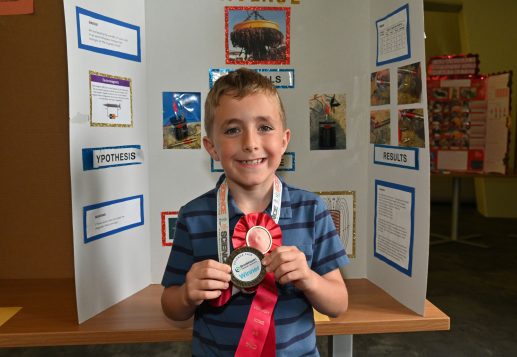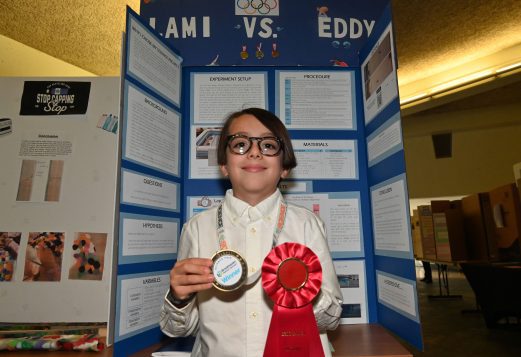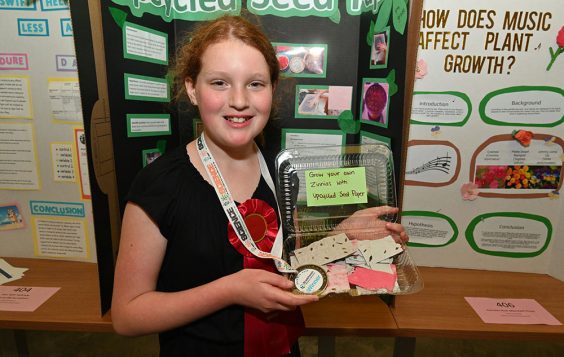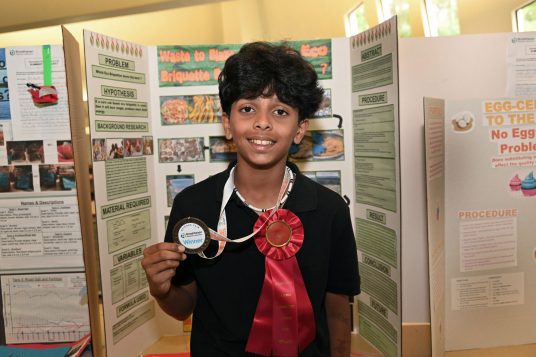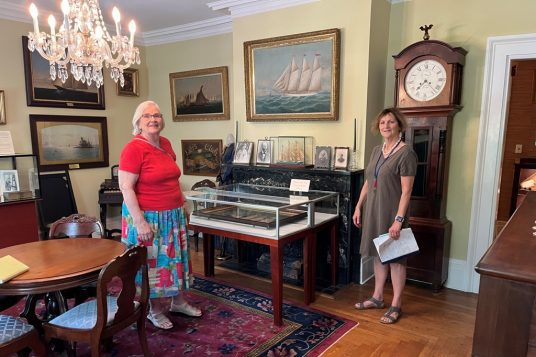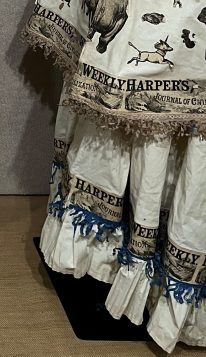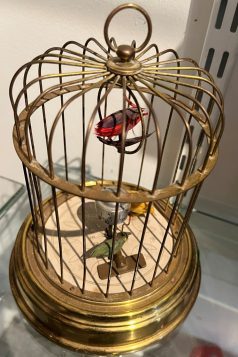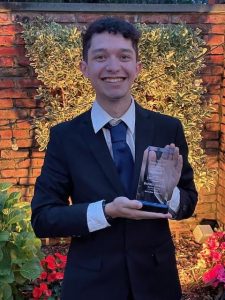The annual Elementary Science Fair Competition hosted by the U.S. Department of Energy’s (DOE) Brookhaven National Laboratory on June 7 showcased a range of hypotheses students set out to test by following the scientific method.
Students presented questions inspired by their everyday lives, their interests, and timely topics in science. This year’s project titles included, “Alexa, Do my Homework!” “Does Taylor Swift Help Make my Dog Less Anxious?” “How Does the Air Pressure of a Soccer Ball Affect how far it Travels When Kicked?” and “Words Matter: How Encouragement Affects Performance.”
Brookhaven Lab scientists and local teachers volunteered to judge 258 projects and award the top spots and honorable mentions for each grade level, from kindergarten to sixth grade. The competition also included a Judges’ Choice award for creative questions.
“Our Elementary Science Fair is all about celebrating students’ first steps in STEM and providing positive memories that will inspire them as they consider future career paths,” said Daniel Trieu, competition co-coordinator and educational programs representative with Brookhaven Lab’s Office of Workforce Development and Science Education (WDSE). WDSE provides educational opportunities that highlight the Lab’s research initiatives, preparing the next generation of scientists and engineers.
A number of projects pulled in family and friends, including four-legged ones. Kindergarten student Savanna Stidd of Riley Avenue Elementary School wondered, “Am I really my dog’s best friend?” and found that her pup named Penny ran to her the fastest when called over. Her favorite part of the process? “I got to play with my dog,” she said.
Some students combined science and art, exploring how different types of music play into plant growth, whether music affects the way we draw, and which conditions contribute to the perfect place to hang their paintings. Others asked questions about food, including a project that tested which substance best mummified apples — complete with a life-size display prop mummy — and another that investigated why a student’s favorite ice cream flavor, chocolate, melts quickly in the summer.
Overall, the Science Fair is a chance to highlight students’ curiosity about the scientific process.
“My favorite part about being at the Science Fair is looking at my Science Fair project and seeing how hard I worked for it,” said Elijah David, a third grader from Coram Elementary School who conducted an experiment to see which liquids dissolved different types of candy the fastest.
Students who earned first place in their grade level received medals and ribbons, along with banners to hang at their school to recognize the achievement. All participants received a ribbon in recognition of having won their grade-level competition at their school. Brookhaven Lab and Teachers Federal Credit Union sponsored the competition.
Science Fair awards
The following students earned first place in their grade level:
◆ Kindergartner Athena Corso, Lincoln Avenue Elementary School in Sayville for “Don’t Wake a Sleeping Baby.”
◆ First grader John Jantzen, Sunrise Drive Elementary School in Sayville for “Electromagnet Avenue.”
◆ Second grader Christopher Calvanese, Pines Elementary School in Smithtown for “Monkey Bars or Ouchy Scars: Which playground surface absorbs the most impact?”
◆ Third grader Erios Pikramenos, Joseph A. Edgar Intermediate School in Rocky Point for “Lami vs. Eddy.”
◆ Fourth grader Lyla Drucker, Tamarac Elementary in Holtsville for “Upcycled Seed Paper.”
◆ Fifth grader Taran Sathish Kumar, Pines Elementary School in Smithtown for “Waste to Blaze: Which Eco-Briquette Burns the Best.”
◆ Sixth grader Luke Dinsman, Northport Middle School in Northport for “Defeating Drought: Can Hydrogels Help?”
Judges’ choice
Kindergarten: Nate Doherty, Miller Avenue School in Shoreham
First Grade: Jack Gottesman, Tamarac Elementary School in Holtsville
Second Grade: Indie Crooke, Hampton Bays Elementary School in Hampton Bays
Third Grade: Colton Christian, Dayton Avenue School in Manorville
Fourth Grade: Mabel Gross, Dayton Avenue School in Manorville
Fifth Grade: Morgan Proscia, Sunrise Drive Elementary School in Sayville
Honorable mentions
Kindergarten: Arjun Yelika, Laurel Hill School in East Setauket; Savanna Stidd, Riley Avenue Elementary School in Calverton; and Peyton Lauten, Frank J. Carasiti Elementary in Rocky Point
First Grade: Grady McHugh, Pines Elementary School in Smithtown; and Cecilia Singh, Edna Louise Spear Elementary in Port Jefferson
Second Grade: Maggie Ruddick, Ridge Elementary School in Ridge; Rudhvin Maheshkumar, Bretton Woods Elementary School in Hauppauge; and Nathan Kenny, Hiawatha Elementary in Lake Ronkonkoma
Third Grade: Emilia Rutigliano, Tamarac Elementary in Holtsville; Adalynn Bishop, Raynor Country Day School in Speonk; George Miyagishi, Park View Elementary School in Kings Park; Christopher Powell, Fifth Avenue School in East Northport; and Siena Roseto, Cutchogue East Elementary School in Cutchogue.
Fourth Grade: Kate Unterstein, Cutchogue East Elementary School in Cutchogue; Myles Savage, RCK Elementary School in Islip Terrace; Lily Argyros, Bretton Woods Elementary School in Hauppauge; Vincent Calvanese, Pines Elementary School in Smithtown; and Ruby Tafflock, Ocean Avenue School in Northport.
Fifth Grade: Sofia Balcells, Raynor Country Day School in Speonk; and Ashleigh Bruno, Northport Middle School in Northport.
Sixth Grade: William Zeiger, Peconic Community School in Cutchogue; and Colette Breig, William T. Rogers Middle School in Kings Park.
Science Fair Expo
While the project showcase was underway, science fair participants and their families also visited the Science Fair Expo, which featured information about Brookhaven Lab, science demonstrations, and hands-on activities related to physics, nanoscale science, and more.
Brookhaven National Laboratory is supported by the Office of Science of the U.S. Department of Energy, the single largest supporter of basic research in the physical sciences in the United States. For more info, visit science.energy.gov.


